RARE Clitso Dedman Sixteen Figure Yeibichai Dance Carving Set - [SOLD]
+ Add to my watchlist Forward to Friend
- Category: Other Items
- Origin: Diné of the Navajo Nation
- Medium: cottonwood, paint, feathers
- Size:
each is between 9-¼” and 12” height - Item # C4620A SOLD
This exceptionally rare set of sixteen carvings was created in the late 1940s by Clitso Dedman, a Diné folk artist who discovered his signature creative practice late in life. Dedman was born in or around 1879 in Chinle, Arizona. As a teenager, he was sent to the Grand Junction Indian School. His education served him well, and he returned to Arizona a skilled blacksmith and carpenter. He was fluent in English, and was one of just a few of his peers who could read and write. Dedman worked for years in and around his hometown as a carpenter, mechanic, and stone mason.
Later, he would marry, adopt Catholicism, and shift his energies toward working as a trader in his wife’s hometown of Nazlini. Dedman, notably, was one of the first Diné people to achieve success in the anglo-dominated field of reservation trading. After expanding and selling his trading post to Ganado trader John Lorenzo Hubbell, Dedman returned to Chinle, where he befriended trading post owner Cozy McSparron. Dedman supervised the successful expansion of McSparron’s business and home while operating his own blacksmith shop. During this time period, he separated from his first wife and married Mary Brown, a skilled weaver who was also a devout Catholic.
In 1940, Dedman unexpectedly produced a set of four small carvings, which he gifted to McSparron’s daughters. They were depictions of figures from the Yeibichai Dance, the conclusion of the nine-day Nightway healing ceremony. McSparron, impressed by the quality of work, encouraged Dedman to continue carving. Dedman—now in his sixties, with health issues necessitating retirement from the laborious pursuits of his earlier life—devoted the rest of his life to exploring what was, at the time, an entirely new art form. Creating representations of ceremonial figures was frowned upon by the Diné people. Many believed in what has been referred to as a “Yeibichai curse,” which would strike those who misused ceremonial figures with paralysis and blindness. Some have speculated that Dedman either did not believe in or felt that he was exempt from the curse, possibly because of his Catholic faith. However, it is worth noting that he is known to have omitted certain significant details from his figures’ regalia, which suggests a somewhat significant measure of respect for tradition.
Dedman’s works, the majority of which depicted groups of sixteen Yeibichai Dance participants, caught the attention of collectors and traders as they became more refined in the mid-1940s period. Today, they are sought by museums and private collectors alike because of both beauty and rarity—Dedman carved no more than thirty of these sixteen-figure sets during his career. A handful of additional, smaller sets were produced as well, but the sixteen figure format was Dedman’s preference.
 This complete Yeibichai Dance set was likely completed in 1947 or 1948, during what scholars and collectors consider to be Dedman’s strongest creative period. The figures from this period are detailed and realistic, with accurate anatomical features and thoughtful depictions of ceremonial regalia. A legible Clitso signature on the bottom of each figure’s foot is another hallmark of this mid- to late-1940s classic period. Earlier figures were generally larger, less detailed, simpler in color, and unsigned. Later works were made in collaboration with family members due to Dedman’s arthritis and other health issues. Late-career pieces are adorned with new materials and additional details, but they lack the consistency, sensitivity, and precision seen in works from the previous period. Signatures appear on later pieces, but they are often illegible.
This complete Yeibichai Dance set was likely completed in 1947 or 1948, during what scholars and collectors consider to be Dedman’s strongest creative period. The figures from this period are detailed and realistic, with accurate anatomical features and thoughtful depictions of ceremonial regalia. A legible Clitso signature on the bottom of each figure’s foot is another hallmark of this mid- to late-1940s classic period. Earlier figures were generally larger, less detailed, simpler in color, and unsigned. Later works were made in collaboration with family members due to Dedman’s arthritis and other health issues. Late-career pieces are adorned with new materials and additional details, but they lack the consistency, sensitivity, and precision seen in works from the previous period. Signatures appear on later pieces, but they are often illegible.
This set includes excellent depictions of all of the expected Yeibichai Dance participants. The central figure is Talking God, a powerful Diné deity who wears a white mask with a fantail of feathers. The man in traditional garb is the medicine man; he officiates the ceremony with a blanket over his shoulder and a pouch of sacred pollen in his hand. The woman who holds a basket is the patient. She is the main beneficiary of the ceremony’s healing and balance-restoring effects, which extend also to all in attendance and the entire Diné community. Men and women appear as patients in roughly equal numbers throughout Dedman’s career. Six male Yeis appear in this set, with pairs of feathers rising from round blue masks. Six female Yeis, which are actually performed by young men, appear as well. They wear square masks and carry bunches of feathers and twigs. The final participant is Water Sprinkler, the Diné God of Precipitated Waters. He looks similar to the male Yeis, with the notable addition of Spruce garlands and a kit fox pelt, which he wields in a comedic mimicry of Talking God.
Each figure was meticulously carved out of the branches and trunks of Cottonwood trees. Hopi katsina carvers preferred Cottonwood root, which is softer and easier to manipulate; Dedman’s background as a stone carver likely informed his skillful handling of the tree’s stronger elements. The figures are beautifully painted using the expansive color palette associated with Dedman’s classic period. On a technical level, each and every element is strong and appealing. What is most impressive, though, is the way the figures come together so naturally as a group. Each individual piece is beautiful, but together, they form an undeniably powerful ceremonial scene. It’s been about thirty years since we last had an opportunity to handle a complete set of Dedman’s carvings, and we are delighted to have an opportunity to offer this exemplary set. It is truly a privilege to spend time exploring this rare, beautiful group of carvings.
Condition: excellent condition with a broken and repaired arm only on one figure.
Provenance: Private Albuquerque collection, obtained through the Indian Pueblo Cultural Center
References:
- Rebecca M. and Jean-Paul Valette, The Life and Work of Clitso Dedman, Navajo Woodcarver (1879?-1953), American Indian Art Magazine, 25:2 (Spring 2000), pp. 54-67. A copy of this publication is included with the purchase of this set.
- Rebecca M. Valette and Jean-Paul Valette, Navajo Weavings with Ceremonial Themes: A Historical Overview of a Secular Art Form. (Atglen, PA: Schiffer Publishing, 2017), pp. 229-233
TAGS: Diné of the Navajo Nation, Other Fine Southwest Collectibles
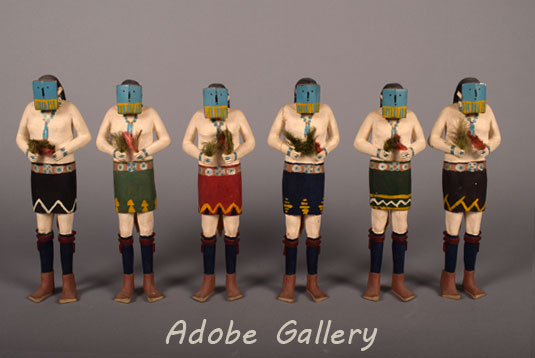
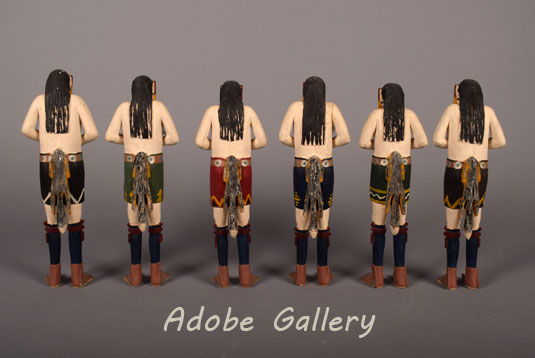
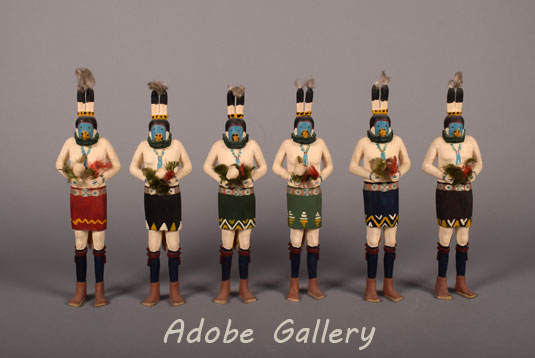
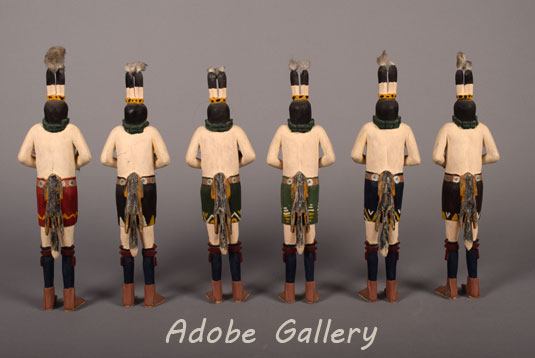
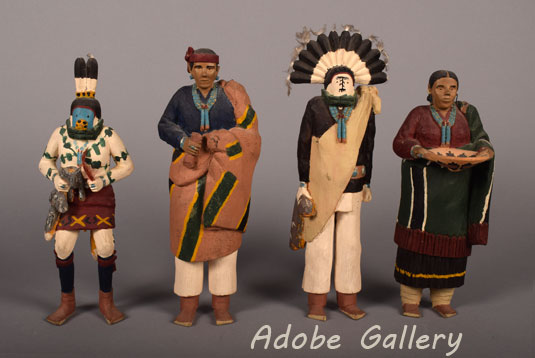
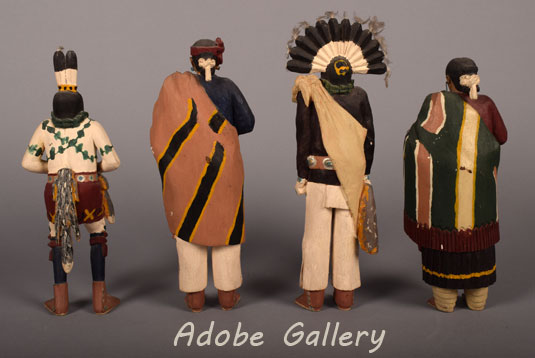
- Category: Other Items
- Origin: Diné of the Navajo Nation
- Medium: cottonwood, paint, feathers
- Size:
each is between 9-¼” and 12” height - Item # C4620A SOLD



